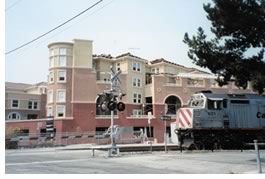
Category: Policies and Regulations
San Mateo's TOD Incentive Program uses state and federal transportation funds to encourage construction of housing near rail stations. The program spurs construction of needed housing and creates environmental benefits by locating development near transit—giving people the option of commuting and running errands by rail.
 In
California and in local governments across the country, land-use decisions
often focus on maximizing sales tax revenue to balance budgets, which
creates a greater incentive to build office and retail space, but a disincentive
to construct housing. As jobs and housing spread out, transportation systems
can become overburdened. Modeling showed that San Mateo County could reduce
congestion by locating more housing near transit stations. To address
a housing shortfall, reduce congestion, and improve environmental quality,
the City/County Association of Governments of San Mateo County (C/CAG)
provides incentives for land use agencies (20 constituent cities as well
as the county) to create housing near transit stations. C/CAG allocates
up to 10 percent of State Transportation Improvement Program funds for
the San Mateo County TOD Incentive Program.
In
California and in local governments across the country, land-use decisions
often focus on maximizing sales tax revenue to balance budgets, which
creates a greater incentive to build office and retail space, but a disincentive
to construct housing. As jobs and housing spread out, transportation systems
can become overburdened. Modeling showed that San Mateo County could reduce
congestion by locating more housing near transit stations. To address
a housing shortfall, reduce congestion, and improve environmental quality,
the City/County Association of Governments of San Mateo County (C/CAG)
provides incentives for land use agencies (20 constituent cities as well
as the county) to create housing near transit stations. C/CAG allocates
up to 10 percent of State Transportation Improvement Program funds for
the San Mateo County TOD Incentive Program.
 A
jurisdiction receives incentive funds based on the number of bedrooms
in the housing units. Typically, projects receive up to $2,000 per bedroom.
In order to be eligible for the program, housing must be within one-third
of a mile of a rail transit station, and density must be at least 40 units
per acre. In the event that the program is oversubscribed, C/CAG may reduce
the funding per bedroom or provide additional funding. Land use agencies
only receive funding once the units are built or are under construction.
Funds are then used to support improvements either on or off-site as determined
by the land use agency. In addition to direct transportation improvements,
some general improvements such as landscaping, lighting, sidewalks, plazas,
and recreational projects are allowed.
A
jurisdiction receives incentive funds based on the number of bedrooms
in the housing units. Typically, projects receive up to $2,000 per bedroom.
In order to be eligible for the program, housing must be within one-third
of a mile of a rail transit station, and density must be at least 40 units
per acre. In the event that the program is oversubscribed, C/CAG may reduce
the funding per bedroom or provide additional funding. Land use agencies
only receive funding once the units are built or are under construction.
Funds are then used to support improvements either on or off-site as determined
by the land use agency. In addition to direct transportation improvements,
some general improvements such as landscaping, lighting, sidewalks, plazas,
and recreational projects are allowed.
For the first cycle, October 1999 to September 2001, C/CAG programmed $2.3 million to the TOD Incentive Program to support development of 1,282 bedrooms in five projects. The second cycle (February 2002 to February 2004) has programmed nearly $3 million for 10 projects to facilitate the creation of 2,407 bedrooms.
Copyright 2002 The American Institute of Architects. All rights reserved.
![]()
|
|
|